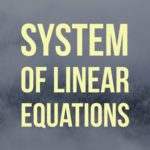Find All Matrices $B$ that Commutes With a Given Matrix $A$: $AB=BA$

Problem 272
Let
\[A=\begin{bmatrix}
1 & 3\\
2& 4
\end{bmatrix}.\]
Then
(a) Find all matrices
\[B=\begin{bmatrix}
x & y\\
z& w
\end{bmatrix}\]
such that $AB=BA$.
(b) Use the results of part (a) to exhibit $2\times 2$ matrices $B$ and $C$ such that
\[AB=BA \text{ and } AC \neq CA.\]
Sponsored Links
Contents
Solution.
Find all matrices $B$ such that $AB=BA$
Since we want to find $B$ such that $AB=BA$, we need to find $x, y, z, w$ satisfying
\[\begin{bmatrix}
1 & 3\\
2& 4
\end{bmatrix}\begin{bmatrix}
x & y\\
z& w
\end{bmatrix}=\begin{bmatrix}
x & y\\
z& w
\end{bmatrix}\begin{bmatrix}
1 & 3\\
2& 4
\end{bmatrix}.\]
Comparing entries, we have the following system of linear equations.
\begin{align*}
x+3z&=x+2y\\
y+3w&=3x+4y\\
2x+4z&=z+2w\\
2y+4w&=3z+4w.
\end{align*}
Simplifying this, we obtain
\begin{align*}
2y-3z &=0\\
3x+3y-3w &=0\\
2x+3z-2w &=0\\
2y-3z &=0.
\end{align*}
Note that the first and the last equations are identical. So we omit the first equation from our consideration.
To solve this system, we use the Gauss-Jordan elimination method. Namely we form the augmented matrix of this system and apply elementary row operations as follows.
\begin{align*}
\left[\begin{array}{rrrr|r}
3 & 3 & 0 & -3 &0 \\
2 & 0 & 3 & -2 & 0 \\
0 & 2 & -3 & 0 & 0
\end{array}\right]
\xrightarrow{\frac{1}{3}R_1}
\left[\begin{array}{rrrr|r}
1 & 1 & 0 & -1 &0 \\
2 & 0 & 3 & -2 & 0 \\
0 & 2 & -3 & 0 & 0
\end{array}\right]
\xrightarrow{R_2-2R_1}\\[10pt]
\left[\begin{array}{rrrr|r}
1 & 1 & 0 & -1 &0 \\
0 & -2 & 3 & 0 & 0 \\
0 & 2 & -3 & 0 & 0
\end{array}\right]
\xrightarrow{\substack{R_1+\frac{1}{2}R_2 \\ R_2+R_3}}
\left[\begin{array}{rrrr|r}
1 & 0 & 3/2 & -1 &0 \\
0 & -2 & 3 & 0 & 0 \\
0 & 0 & 0 & 0 & 0
\end{array}\right]\\[10pt]
\xrightarrow{-\frac{1}{2}R_2}
\left[\begin{array}{rrrr|r}
1 & 0 & 3/2 & -1 &0 \\
0 & 1 & -3/2 & 0 & 0 \\
0 & 0 & 0 & 0 & 0
\end{array}\right].
\end{align*}
The last matrix is in reduced row echelon form. From this, we obtain the general solution
\begin{align*}
x&=-\frac{3}{2}z+w\\
y&=\frac{3}{2}z,
\end{align*}
where $z$ and $w$ are free variables.
Therefore the matrix $B$ such that $AB=BA$ must be
\begin{align*}
B&=\begin{bmatrix}
-\frac{3}{2}z+w & \frac{3}{2}z\\
z& w
\end{bmatrix}\\
&=z\begin{bmatrix}
-\frac{3}{2} & \frac{3}{2}\\
1& 0
\end{bmatrix}
+w
\begin{bmatrix}
1 & 0\\
0& 1
\end{bmatrix}
\end{align*}
for any $z$ and $w$.
(b) Find matrices $B, C$ such that $AB=BA$, $AC\neq CA$
By part (a), if
\[B=z\begin{bmatrix}
-\frac{3}{2} & \frac{3}{2}\\
1& 0
\end{bmatrix}
+w
\begin{bmatrix}
1 & 0\\
0& 1
\end{bmatrix}\]
for some $z, w$, then we have $AB=BA$.
For example, let $z=2, w=0$. Then the matrix
\[B=\begin{bmatrix}
-3 & 3\\
2& 0
\end{bmatrix}\]
satisfies $AB=BA$.
To find a matrix $C$ such that $AC \neq CA$, the matrix $C$ must not be of the form of the formula of $B$.
For example, let
\[C=\begin{bmatrix}
0 & 0\\
1& 0
\end{bmatrix}.\]
You may directly check that $AC\neq CA$.
Or, we can show that $C$ is never be the matrix of the form
\[\begin{bmatrix}
-\frac{3}{2}z+w & \frac{3}{2}z\\
z& w
\end{bmatrix}.\]
To see this, compare $(1,2)$ and $(2,1)$ entries. There is no $z$ such that
\[\frac{3}{2}z=0 \text{ and } z=1.\]
(This is how I found the matrix $C$ as above.)
 Add to solve later
Add to solve later
Sponsored Links
















